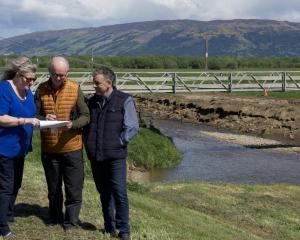Dunedin councillors have voted for one-way traffic in Dunedin's main shopping street, George St.
That traffic will flow north to south, towards the Octagon.
After a marathon discussion, councillors voted 9-5 for a one-way design.
They voted 11-2 for the one-way south option and Cr Andrew Whiley abstained.
- For one-way traffic: Mayor Aaron Hawkins, Christine Garey, Sophie Barker, David Benson-Pope, Marie Laufiso, Jim O'Malley, Steve Walker, Mike Lord, Chris Staynes.
- Against: Jules Radich, Carmen Houlahan, Rachel Elder, Lee Vandervis, Andrew Whiley.
The three options being discussed were a one-way north, one-way south and a two-way design that would promote pedestrian activity.
A 30kmh speed limit would apply for the alternative do-minimum approach, in which underground pipe work would go ahead, but the street would look much the same as now.
The do-minimum option would amount to an abandonment of a George St revamp.
Dunedin Mayor Aaron Hawkins moved that traffic should be one-way in George St and that the direction should be southbound.
"This is about providing a safe and appealing destination," he said.
Dunedin should pursue the safest, most inclusive city centre it could build, Mr Hawkins said.
Underground work was needed to replace old pipes and a revamp was needed above ground, too.
"Why wouldn't we seize the opportunity that we have?"
Councillors needed to make a decision that was in the long-term interests of everybody in the community, he said.
Cr Jules Radich said one-way traffic was a polarising political statement and an upgraded street with two-way traffic would have been less contentious.
Cr Andrew Whiley noted there was a lack of commentary about how the building of the new Dunedin Hospital might affect traffic.
Deputy mayor Christine Garey said one-way traffic was the best option for people who were vulnerable, such as those with disabilities.
One-way traffic would apply between Frederick St and Moray Pl.
Public opinions
Councillors listened to various views expressed in a public forum this morning.
Otago University Students' Association representative Mhairi Mackenzie Everitt called for the one-way south option, saying the flow would be into the city, rather than heading out of it.
Dunedin had fallen behind other cities in creating an accessible, welcoming and safer city centre, she said.
George St could be transformed into a destination, rather than just a thoroughfare, she said.
Public Health South health promotion adviser Louise Mainvil said people needed to be able to congregate where there was shade, shelter and places to stop and rest.
She called for drinking fountains to be part of the proposed upgrade for the area.
CCS Disability Action Group Otago representative Mary O'Brien said the decision to be made by councillors would influence liveability and wellbeing in the city.
She doubted motorists would stick to a 10kmh limit if a two-way George St was preferred.
Automobile Association Otago district chairman Malcolm Budd said a one-way George St would increase traffic congestion in the area.
He called for a 20kmh speed limit in the street, because 10kmh would be unrealistic and unenforceable.
Urban Access Dunedin representative Alan Race said limiting access to the central business district would result in fewer people visiting, unless there was adequate parking or a loop bus service.
His preference was for two-way traffic, but if councillors chose a one-way design, he favoured one-way south.
Generation Zero representatives said a one-way George St was an essential step towards a sustainable city.
Making it a "pleasant location" would would attract more people to it.
Grey Power Otago president Jo Millar said looking after the needs of permanent residents would also enhance the area for university students.
"If it works for the elderly, it will work for anybody."
Disabled Persons Assembly representative Chris Ford said the city had an opportunity to make a statement in designing a city centre that supported people's wellbeing.
Bus Users Advisory Group representative Alex King said if the public bus service had to move off George St, then it needed to be as easy as possible to use in Great King St.
The detailed business case councillors are considering about the proposed George St upgrade comments there are aspirations for the street to be viewed as a destination, but it is often used as a thoroughfare.
Motorists also tended to travel in circles in the area looking for car parks.
Councillors engaged in an exhaustive period of asking questions of council staff this afternoon.
Comments
Not really much use making a public submission since the council has a track record of not listening.
I'm really hoping they ignore the vocal minority this time and go with the one way option, it's a little unfortunate that they aren't considering a pedestrian only option but we have to take the best option provided!
At last! Now get on with it.
DCC are delusional if they think they are going to attract more ratepayers into the city with this half baked plan. This Council is anti ratepayer, apart from extracting more money from us they have failed miserably to create a sustainable city centre. The slums and derelict building on our main street (Princes Street) are a public disgrace. Another extreamly silly proposal is the installation of public drinking fountains, haven't these people heard of Covid and the risk of this and other diseases being transmitted through contaminated drinking water. Not everyone one is as smart as our councillors and may not use this type of utility in a sanitory way. I dispair!@#*?
Public drinking fountains cannot transmit diseases unless the water is already contaminated, in which case the water in your Dunedin home is not safe to drink either. Unless several people are trying to drink from the fountain at the same time, breathing in each other's faces, catching Covid from drinking at an outdoor fountain is less likely than drinking in an enclosed space such as a bar or cafe.
There used to be at least one drinking fountain. It was on one of the streets crossing George St, perhaps Hanover, just up from the pedestrian crossing. There may have been others.
Great news. And hopefully before long it will become clear to everyone, including shop owners, that full pedestrianisation will be even better. The small but vocal minority against have their head in the sand and don't want to admit the 1970's were a long time ago! In 10 years time we will not be able to understand what all the fuss was about.
This great news. We'll done to the council, slowly moving Dunedin towards a contemporary city.
What a pack of no hope and no idea councilors - if they had to apply for a job - they would be on the unemployment registry for the rest of their lives - they stuffed up the Octagon and business' went broke and NOW George Street - Good luck retailers - your days are numbered - for us local rate payers - Hawkins - get a real job and pay your way.
A ridiculous decision that I hope is only a trial because the fastest way to get people out of the city centre is to deny them or restrict them from using their cars there. So the DCC wants to depopulate the city centre where the retail business are. How clever that is, NOT.
What is the reason for a central business district?
'Making it a "pleasant location" would would attract more people to it.' This may be true. Dunedin is not short of pleasant locations so attracting more people to the CBD instead of the Botanic Gardens and St Clair and Tanner Glen and Woodhaugh and... etc... is hardly necessary. The difference between those attractive places and the CBD is money, the CBD being the one that exists for business. It needs to attract not merely people, but people who spend, who conduct business in their shops, travel agencies, eateries and drinkeries and professional premises. Without spenders the businesses close, or relocate to where the spenders are. Businesses do not, cannot, exist to provide a backdrop for public gatherings. Councillors and planners needs to keep this in the forefront of their minds when making changes.
Along with the effects of the nearby hospital rebuild on traffic flow, watch the city's central streets go into a semi-permanent state of gridlock, thanks to this traffic engineering master stroke. They were warned.











